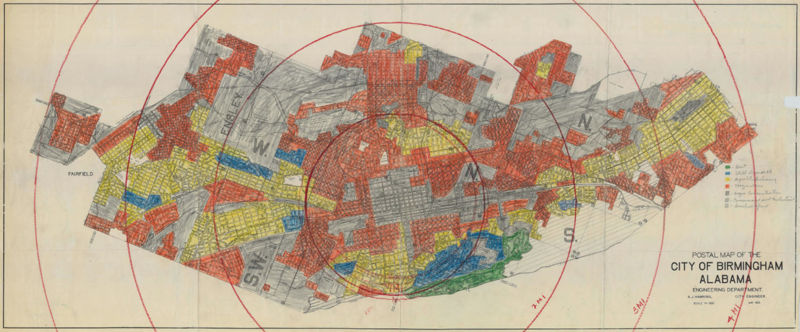Most Segregated City in America
- This article is about the description of Birmingham. For the book, see The Most Segregated City in America: City Planning and Civil Rights in Birmingham, 1920–1980.
The Most Segregated City in America is a description that has been applied to Birmingham in different eras, referring to its structurally-embedded system of racial segregation, ranging from social preference to city ordinances to political and planning policies that shaped the profoundly segregated landscape of the region which, despite the periodic victories for racial equality, persists today.
Martin Luther King Jr used the phrase in his famed Letter from Birmingham Jail, saying in a section regarding the collection of evidence of injustice as a prerequisite for staging a nonviolent confrontation, that "Birmingham is probably the most thoroughly segregated city in the United States." The Birmingham campaign which his Southern Christian Leadership Conference came to help stage was aimed primarily at public accommodations, such as segregated restrooms, water fountains, dressing rooms, parks and lunch counters, as well as barriers to employment for qualified African Americans seeking work in shops and city offices.
Charles Connerly's 2005 book, The Most Segregated City in America: City Planning and Civil Rights in Birmingham, 1920–1980, explains how the city used its planning policies to reinforce residential segregation in the city, flaunting the anti-segregation requirements of federal programs from which it took most of its funding for transportation, housing and urban renewal projects.
Once the Birmingham campaign and other demonstrations of the Civil Rights Movement achieved their political aims with U.S. Supreme Court rulings rejecting "separate but equal" public facilities and the passage of the Civil Rights Act of 1964 and the Voting Rights Act of 1965, Birmingham experienced unprecedented internal migrations, or "white flight", into suburban enclaves still protected from integration by economic and social barriers, including racial discrimination in the real estate and mortgage loan sectors. Part of this movement was the proliferation of independent municipally-owned public school districts, which broke away from Jefferson County Schools and have remained nearly all-white, despite forced busing.
These practices further embedded racial segregation into the region's physical and social structures in ways that are sometimes not apparent and are difficult to redress, even as a greater number of people discount racism as a factor in contemporary socio-economic inequalities.
Using data from the U.S. Census Bureau’s 2013 American Community Survey, researchers for the magazine 24/7 Wall Street identified the Birmingham-Hoover Metropolitan Area as the eighth most segregated urban region in the United States. They found that roughly 40% the area's residents live in ZIP codes with nearly uniform racial composition, and that there is plenty of evidence of segregation by race within ZIP codes.
In 2016 the New Jersey-based non-profit EdBuild conducted a survey of school district boundaries to determine which ones most effectively separated high- and low-poverty areas. Six Birmingham-area school systems ranked in the study's "50 Most Segregating School District Boundaries". The Birmingham area, with its numerous municipal school systems, was an outlier in the South, where most school districts are drawn along county lines.
References
- Connerly, Charles E. (2005) "The Most Segregated City in America": City Planning and Civil Rights in Birmingham, 1920-1980. University of Virginia Press ISBN 0813923344
- Kent, Alexander & Thomas C. Frohlich (August 19, 2015) "America’s Most Segregated Cities" 24/7 Wall Street
- "Fault Lines: America's Most Segregating School District Borders" (2016) EdBuild
